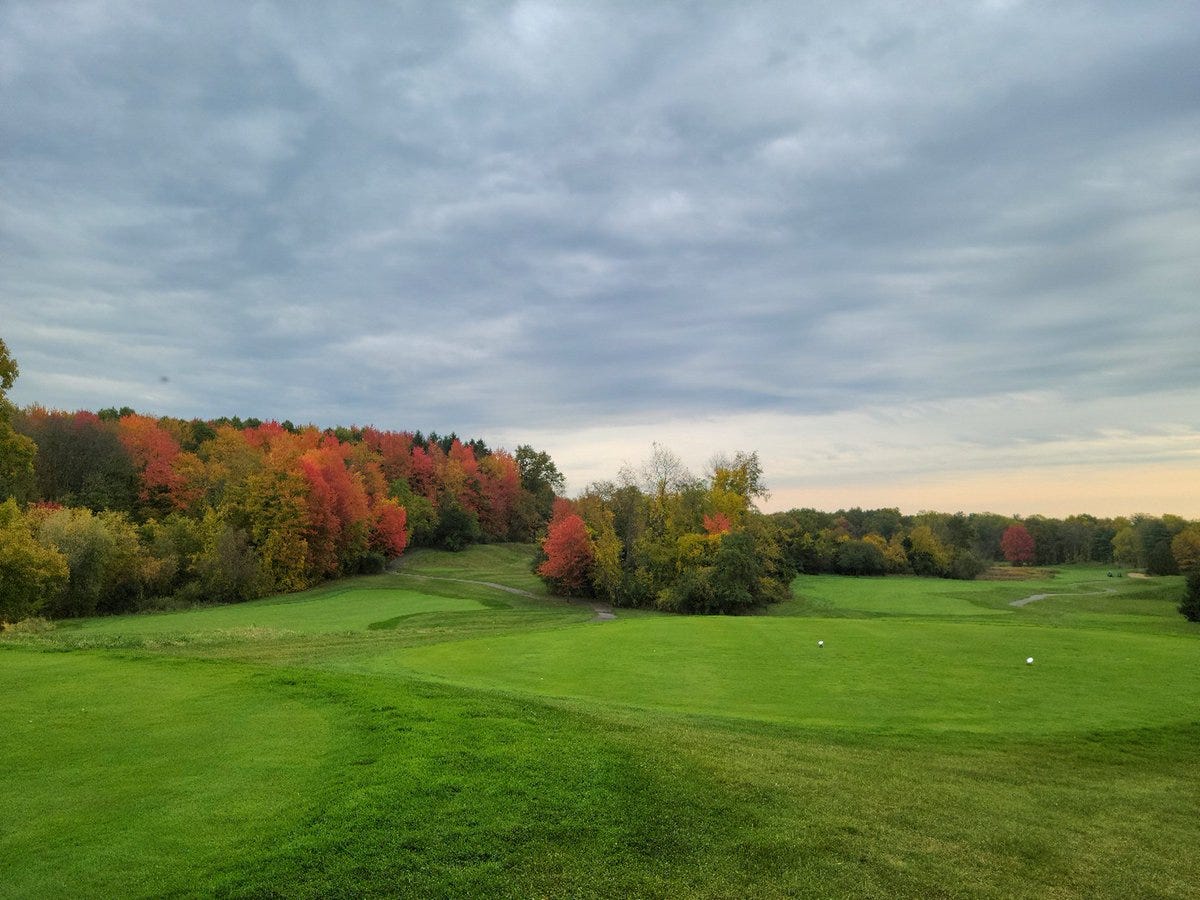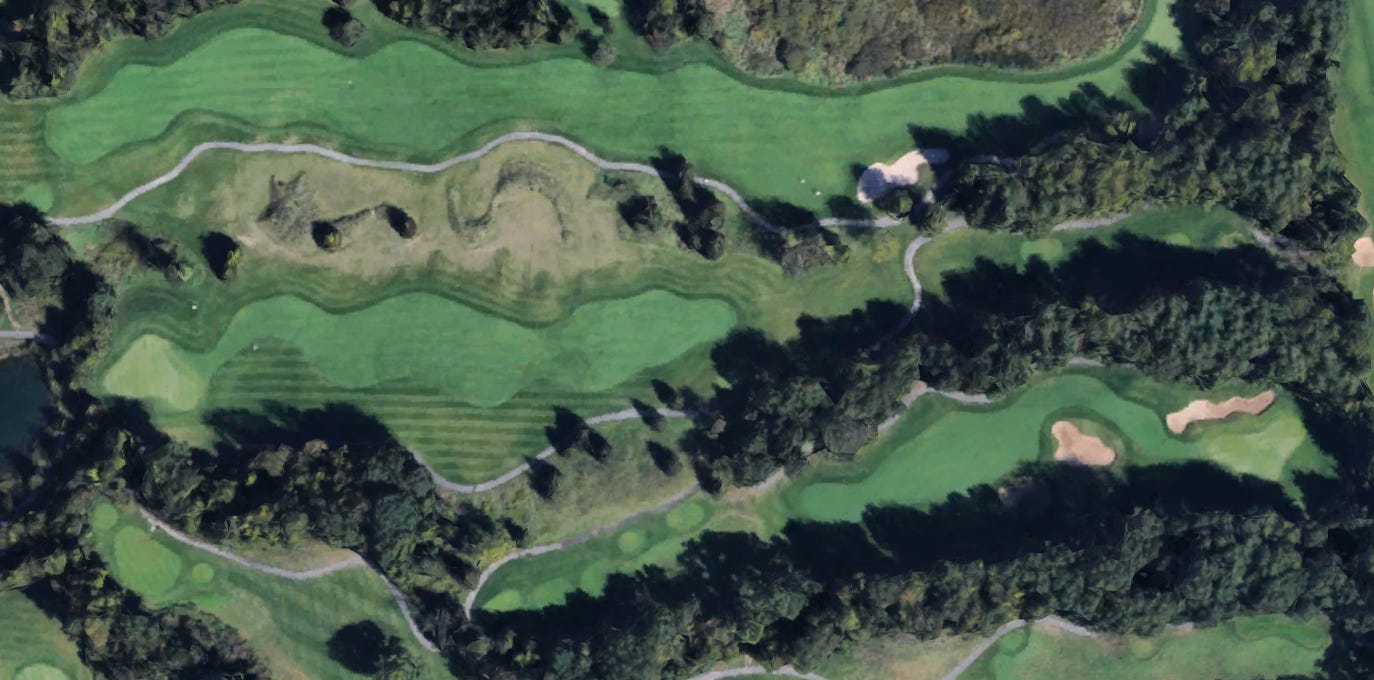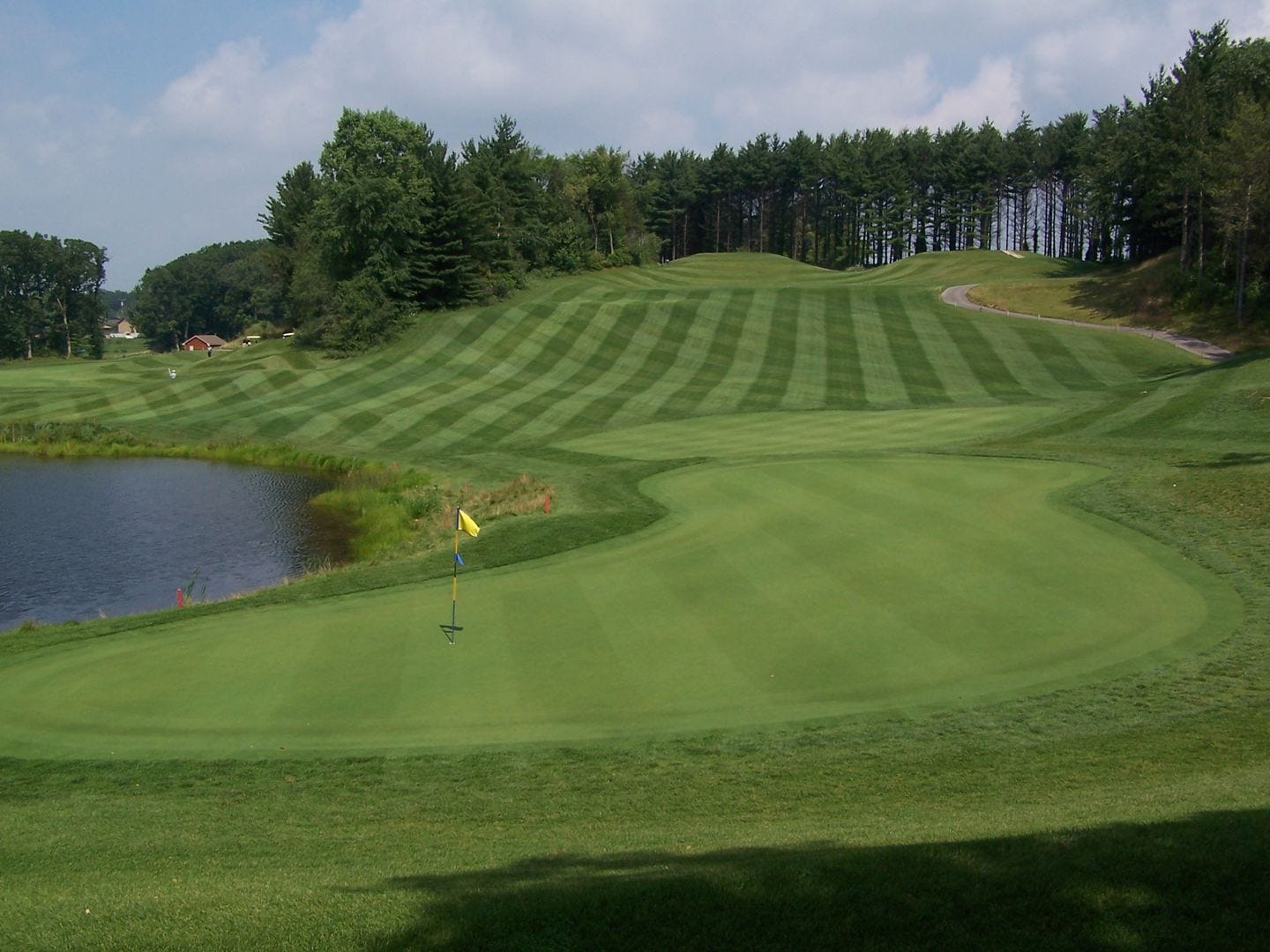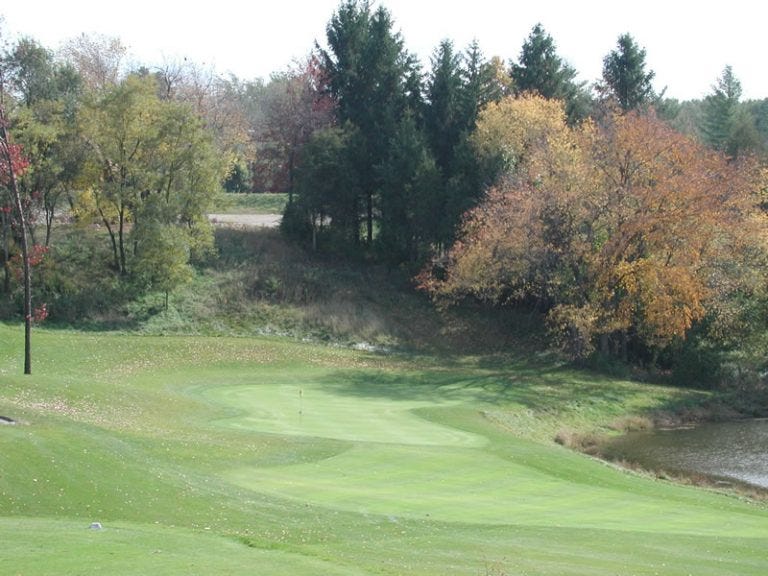I think I’m too old to care about rap battles anymore. I’m just going to assume that Kendrick is winning, because he’s an artistic genius.
I have my own beefs, and I’ve made a few of them known. There’s the Masterpiece, which has been number one on my hit list for years. Then there was Twin Oaks, which was more of a friendly takedown. I’ve been circling my next opponent for a few weeks now, and it’s time for Moose Ridge to face the music.
Kill-a-Course: Moose Ridge
In my previous takedowns, I’ve issued a disclaimer to begin. I understand that regardless of my beef with any course, there are people behind the scenes pouring their passion and sweat equity into the operation. My goal is never to belittle those people who are trying their best. But let’s face it, course criticism exists to try and elevate the product. We could be nice and friendly and offer praise for every course, but if every course is “great”, how do we know what great really is?
Moose Ridge strikes a chord that some people like, clearly. I was reminded recently that the Free Press thinks quite highly of the course.
As I pointed out recently, the Free Press and I clearly look for different qualities in a golf course. However, as much as I disagree with the Freep and as much as I mockingly use the term “Up North Feel”, Moose Ridge is absolutely one of the few Metro Detroit courses can make that claim without an eye roll. The forest and the land movement, combined with a property devoid of any visible housing, does provide an escape from the area’s suburban life. “It’s like being Up North” is almost universally the first praise I hear for the course out of any golfer’s mouth.

Would I take the Up North Feel at Moose Ridge over, say, Shepherd’s Hollow? I wouldn’t. The feeling of sanctuary when you first pull into Shepherd’s Hollow, especially compared to some of its surrounding towns such as Auburn Hills and Pontiac, is so much more stark than at Moose Ridge. The pine forests near the entrance drive and clubhouse, in particular, transport you to a completely different location and make you forget that Auburn Hills is even remotely nearby.
There are many things about a typical Arthur Hills golf course that I have qualms with, but one thing he did get right at Shepherd’s Hollow was the corridors. While the corridors are tightly tree-lined, from edge to edge they are generally more than 60 yards wide, and often up to 80 yards wide, with fairway widths of 40 yards or more not being uncommon.



Contrast that against Moose Ridge, where the corridors on many holes are less than 60 yards wide, sometimes less than 50, and a fairway width of less than 35 yards is not uncommon.
Or consider holes like the 2nd, below, running North to South. Even with a reasonably sized corridor, the fairway is inexplicably cut to one side only, leaving a fairway that is under 25 yards wide for a 400 yard hole. Only an immaculate dispersion pattern off the tee would allow a player to hit that fairway consistently.
So What? Play Better.
I was asked not that long ago if I rate courses based on how well I play them. I believe my answer was something along the lines of, “I try not to make that a determining factor, but I’m subject to being biased about my experience just like any other player”. There is no doubt that that could be the case here, as the second most common refrain that I hear about Moose Ridge from other golfers is that it’s “challenging”, or “tough”. Like many courses, Moose Ridge no doubt positions its course as a “championship test”, a buzzword that many raters often equate with quality.
Here’s the thing. My home course, if you will, is the University of Michigan Golf Course. I’ve been playing that thing for over 20 years now, these days often playing it about 10 times a year. It kicks my ass every time. I know where not to hit it, I generally know the breaks of the greens, and I still haven’t even sniffed breaking 80 there. And I love it. Except for maybe the Kingsley Club, I haven’t found another course I would rather play continually throughout the year.
Let’s look at a difficult hole from UMGC. Here is the par-3 12th hole, which can play anywhere from about 225 to 250 yards, and is the number 2 handicap on the course. If you are lucky enough to catch it on the right day in spring, it can also play into a heavy wind.
An extremely accurate 240+ yard shot is one I can rarely pull off. The front of the green is wide open, though. Anything short is still alive, and if your short game is tight, you still have a more than reasonable opportunity at a par. With a sharp front edge to the green and a steep tier in the middle, it’s certainly not a given, but the point is that you have a chance, and on a good day you could pull it off. Should you rip one off of the tee, however, and end up left or right of the green, recovery becomes exponentially more difficult. This is your choice off of the tee. At no point are you told to hit one perfect shot or else.
Contrast that with the 9th hole at Moose Ridge. The hole plays from 183 to 191 from the back 3 tees, and is almost all carry to the green, covering a marsh and a steep ridge in front of the putting surface. The hole preview says anything right will “usually bounce onto the green”, but I’ve rarely seen that play work. Most shots to the right end up in the forest. Shots to the left tumble down the ridge into the marsh. On multiple occasions, when it is dry enough, I’ve scaled down that ridge and emerged with more than a dozen golf balls. It’s a popular place to miss.
For the average Detroit public golfer, a 175+ yard carry to a tight landing zone is a tough ask. The bailout, according to the hole preview, is past the green. Because of course, for most golfers who will struggle with landing a long iron in a tight window, a more reasonable strategy for them will be to try and hit a 200 yard shot straight, instead.
Simply put, there is one way to play this hole. Hit the shot. Or don’t, and take your double bogey.
If I want to play target practice, I can do that at the driving range. It will be cheaper (it’s currently $92 for a weekend round at Moose Ridge in May), and it will save me the hassle of having to look for my ball in the woods.
Coincidentally, I am reading Mike Kaiser’s The Nature of the Game book right now, and I just came across his list of design characteristics of what he calls the Bandon School of Golf Architecture, essentially the guiding philosophy behind all of the Dream Golf properties in his portfolio.
This isn’t the full list, but I recognized in the characteristics below a kindred spirit in Mike Keiser and how we enjoy golf.
The most basic test: Can you hit your ball, find it, and hit it again? Looking for lost balls interrupts the pace of play and ruins the mood.
The golf course should be playable. This means that all golfers can rely on their own game—whatever that may be—to make their way around the course. The course should not dictate the strategy or the kind of shot that must be played.
The course should be fun, not a punishment. A course is fun if you want to keep on playing after you’ve putted out on 18. It’s fun when you get to play shots at the outer edge of your ability—and have a decent chance of pulling them off.
Look at that second hole again. It dictates the only way to play it, a drive up the right side to a sliver of a fairway. A drive to the left ends up on the lower half of the corridor, where you need to hit a mid- to long-iron uphill out of the rough. If that left side were fairway instead, you would have legitimate options and strategy for the hole. A shot from the lower left fairway would still be more challenging, but at least the average golfer has a fraction of a chance at pulling it off.
How about finding your ball? For the average golfer trying to hit the second fairway, a miss to the right would not be uncommon. Immediately to the right of the fairway is unmaintained forest area*, where balls become almost instantly lost. This shared right miss area between both the second and third holes (to the left in the aerial) eats balls, slows up play early in the round, and since the sightline between the second fairway and third tee is concealed, results in dangerous close calls from golfers who don’t yell fore**.
And is it fun? Do I want to have another crack at the hole as soon as I finish it?
*This is a theme throughout the course. Isolated holes playing through the woods are one thing, but there are several holes that run parallel with each other. Rather than allowing open space between the holes, there are pockets of hazards, such a between the 4th and 5th holes (in the 1st aerial image), that easily result in lengthy searches or lost balls. Losing a ball in these pockets is a needlessly frustrating and un-fun experience.
**I am sticking to my theory that when golfers can see other golfers, they are more likely to yell fore on a wayward shot. When trees conceal sightlines, golfers can excuse not yelling fore by saying they didn’t see or didn’t know the other golfers were there. I know, because I almost got pegged by a ball from the 3rd tee last time I played.
All hope is not lost with Moose Ridge. With some tweaks to mowing lines, removal of trees in the shared areas between holes, and some other minor changes, I think the place still has loads of potential, without requiring wholesale changes. Now if you ask me if I think that would ever have a chance of actually happening, I wouldn’t be so optimistic. But let’s ignore that for now.
Instead, let’s look at the par-3 16th hole, which could be considered the “signature” hole at Moose Ridge, a term that I don’t care for, but likely applies here. Playing anywhere from 153 to 203 yards, it’s a rare one-shotter in Detroit that is steeply downhill, similar to the type of dropshot that you might play on repeat at Treetops. This hole certainly doesn’t hurt the Up North feeling of the Moose.
The green is protected on the right by water, and sits in an amphitheater with a steep slope to the left and behind. For a golfer hoping to hit a heroic shot late in their round, a challenging back right pin position could be too enticing to resist. Whereas for a more conservative golfer who knows their limits, this could be a perfect opportunity to let them play out to the left. The satisfaction of seeing a well-planned shot bound down the hill and onto the green, perhaps equaling or besting a better player in the group who attacks the pin directly, would be a highlight of any player’s round!
That is not what happens here, though. Instead the hill is maintained as rough, where balls regularly get hung up in the grass. What could have been a smart option for a high handicapper, instead results in a downhill chip out of the rough, to a green that runs away and features a water hazard just beyond the back edge. Once again, the golfer is given exactly one option off of the tee, and those who fail are assessed a brutal, un-fun punishment.
A course like Moose Ridge could be outstanding. Isolated in the woods, offering the challenge of plenty of sidehill and off-kilter lies, with an ample amount of room to play without the fear of losing half a dozen balls. It still wouldn’t be walkable with the current routing, unfortunately, but it would absolutely offer one of the best golf experiences in the Metro area.
Instead, replayability is low. A visit once or twice might be a novelty. Good players who want to say they were up to the challenge and shot a good score might relish the opportunity. But for the average golfer, once you have played the course a handful of times, you might find that your joy for the game is sucked right out of you at Moose Ridge, and your wallet will be all the lighter for it.













Hard to disagree. Moose Ridge does have one very playable, fun, and strategic hole -- 14, a mid-long par 5. A wide-open landing area, with a second shot that has to navigate a long, thin, fairway-splitting bunker leading up to the green. Options include laying up short of the bunker (in the wide part of the fairway) for a longer third, choosing one or the other sides of the split fairway (depending on pin location), or going for the hero shot.
I play once or twice a year -- I enjoy the challenge and the setting, but outside of 14 it is very much a "hit it here or else" type course.